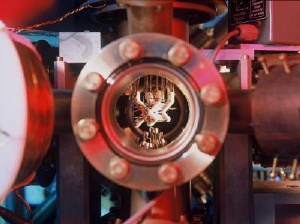Jul 22 2009
In comparison to classical physics, quantum physics predicts that the properties of a quantum mechanical system depend on the measurement context, i.e. whether or not other system measurements are carried out. A team of physicists from Innsbruck, Austria, led by Christian Roos and Rainer Blatt, have for the first time proven in a comprehensive experiment that it is not possible to explain quantum phenomena in non-contextual terms. The scientists report on their findings in the current issue of Nature.
 Experimental physicists use ion traps to store charged atomic particles, and measure quantum effects. Credit: C. Lackner
Experimental physicists use ion traps to store charged atomic particles, and measure quantum effects. Credit: C. Lackner
Quantum mechanics describes the physical state of light and matter and formulates concepts that totally contradict the classical conception we have of nature. Thus, physicists have tried to explain non-causal phenomena in quantum mechanics by classical models of hidden variables, thereby excluding randomness, which is omnipresent in quantum theory. In 1967, however, the physicists Simon Kochen and Ernst Specker proved that measurements have to be contextual when explaining quantum phenomena by hidden variables. This means that the result of one measurement depends on which other measurements are performed simultaneously. Interestingly, the simultaneous measurements here are compatible and do not disturb each other. The physicists led by Christian Roos and Rainer Blatt from the Institute of Quantum Optics and Quantum Information (IQOQI) of the Austrian Academy of Sciences and the University of Innsbruck have now been able to prove this proposition and rule out non-contextual explanations of quantum theory experimentally. In a series of measurements on a quantum system consisting of two ions they have shown that the measurement of a certain property is dependent on other measurements of the system.
Technological headstart
The experiment was carried out by the PhD students Gerhard Kirchmair and Florian Zähringer as well as Rene Gerritsma, a Dutch postdoc at the IQOQI. The scientists trapped a pair of laser-cooled calcium ions in an electromagnetic trap and carried out a series of measurements. „For this experiment we used techniques we had previously designed for building a quantum computer. We had to concatenate up to six quantum gates for this experiment", explains Christian Roos. „We were able to do this because, it is only recently that we can perform a quantum gate with high fidelity." Only last year, a team of scientists led by Rainer Blatt realized an almost error-free quantum gate with a fidelity of 99 %. With this technological headstart, the scientists have now proven comprehensively in an experiment for the first time that the experimentally observed phenomena cannot be described by non-contextual models with hidden variables. The result is independent of the quantum state – it was tested in ten different states. Possible measurement disturbances could be ruled out by the experimental physicists with the help of theoreticians Otfried Gühne and Matthias Kleinmann from the group led by Prof. Hans Briegel at the IQOQI in Innsbruck.
Randomness cannot be excluded
In 1935 already, Albert Einstein, Boris Podolsky and Nathan Rosen questioned whether quantum mechanics theory is complete in the sense of a realistic physical theory – a criticism that is now well know in the scientific world as the EPR paradox. In the mid 1960s, John Bell showed that quantum theory cannot be a real and at the same time local theory, which, in the meantime, has also been proven experimentally. Kochen and Specker's results exclude other theoretical models but until now it was difficult to provide a convincing experimental proof. Following a proposition by the Spaniard Adán Cabello, the Innsbruck scientists have now successfully proven this point and produced unambiguous results experimentally. The physicists are supported by the Austrian Science Funds (FWF), the European Union, the Federation of Austrian Industry Tyrol, and Intelligence Advanced Research Projects Activity (IARPA).